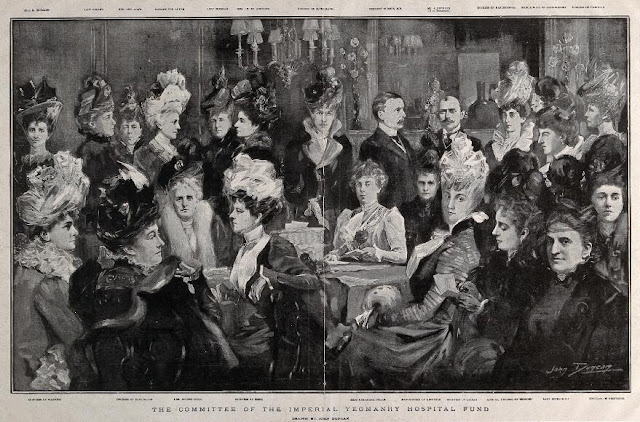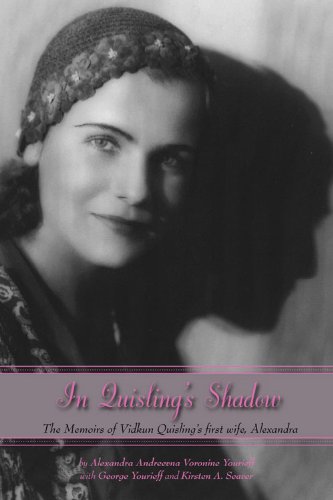The final member in this
series of posts on the members of the Ladies Committee is perhaps the most
colourful and fascinating – and a tad mysterious - with a remarkable career
that took her not just to South Africa, but also to Canada, America, Germany, Italy and Korea where she became
the personal physician to the Emperor.
She was Dr Ella Campbell Scarlett,
another controversial early female doctor with an aristocratic lineage, being
the daughter of the third Baron Abinger, William Scarlett, and his American
wife, Helen Magruder, daughter of Commodore George Allan Macgruder of the U.S.
Navy.
Born in 1864 at Abinger
Hall in Surrey, Ella would have been expected to live the usual social life of
a young high society woman. Her name is often found in newspaper reports of
presentation at court, balls and similar grand occasions. In 1873, she presented a bouquet to Queen
Victoria during a visit to Inverlochy, the ancestral home of the Scarlett
family.
Ella seems to have had wide-ranging interests. She cycled, took photographs and was handy with a gun and, in 1892, she received a first-class degree from the Vienna Conservatory of Music for piano. Yet she still felt constrained by life. Not having made a suitable early marriage she was well into her thirties when she commenced medical training at the London School of Medicine for Women. Apparently, she was inspired to do so after meeting a female Russian doctor.
One newspaper description of Ella is that she was “small and dark, with bright eyes, and any amount of “go” and pluck”. There are only a couple of grainy images of her to be found online, but there must be unpublished photographs or portraits to be discovered in archival or family records.
Plucky she certainly was, for in 1900 Ella was busy. The medical registry records show she received another degree in Brussels and worked as a doctor in Dublin before she travelled to Korea (spelt Corea at that time). As can be seen from this report from
the Bury and Norwich Post of 8 May 1900, she was also interested in fauna and
flora. (Apparently, she also took a course in taxidermy before her travels
there!)
LADY DOCTOR GOING TO COREA.
The Hon. Ella Scarlett, who has been appointed medical adviser to the Emperor of Corea, has sailed to take up her new position. Miss Scarlett is the first lady doctor to settle in Corea. She has a taste for natural history, which she will have an opportunity of indulging out there, as very little is known of the fauna and flora of that part of the world. Miss Scarlett intends, so far as her duties will permit, to make a thorough zoological investigation of the district of Seoul, and has promised to send home the material, to be worked out by specialists here.
It has proven difficult to
find anything much about Ella’s time in Korea and exactly what type of service
she provided to the court. A collection of Korean objects were donated by her
to the Wellcome Collection in the early 1920s, but there doesn’t seem to be any
substantial written memoirs or reports of her time there. (Images here of early 20th Century Korean royalty.)
 |
| The Emperor of Korea in 1900 |
She couldn’t have been in
Korea for very long as within a year or so she was involved in the war in South
Africa where she became the first female doctor in Bloemfontein and was the
resident doctor at the Norvalspont Camp.
 |
| The concentration camp at Norvalspont. |
Ella often made herself unpopular with those in authority. Her fellow Committee member Lucy Deane thought her a little mad (apparently eccentricity ran in the family) and she got up the noses of the officers in charge of the camps. (See the comments in this page from the British Concentration Camps website!)
While in South Africa, she also made what seems to have been an impetuous marriage to Lieutenant Percy Hamilton Synge, eight years younger than her and described by Lucy Deane as good-looking, good-natured but “with not much brains” and it was Millicent Fawcett who gave the bride away. How long they lived together as a couple is hard to establish, but Percy survived WW1 and retired as a Major. He obtained a divorce from Ella in 1921 and later remarried. He died in 1941 and his second wife Eliza in 1962. They had no children.
After the Boer War, Ella briefly
set up a clinic in Kensington, London, in 1904 but then moved to Canada, and
destined to be the first woman doctor at New Westminster’s Royal Columbian Hospital.
During her time in North
America, she also worked in Seattle, Washington, and in Oregon. According to
this Maclean’s article, when living in Edmonton, Alberta, she held Saturday
evening gatherings, that were “probably the nearest approach to an old-world
salon ever held in Alberta’s capital. It is true that her rooms were sometimes
inconveniently crowded and that teacups were at a premium but one might depend
on the company being congenial.”
On the outbreak of WW1,
she helped to establish the Women’s Voluntary Corps in Canada then returned to
Europe where she created more trouble for herself when she went to Serbia. With
her knowledge of German, she became involved with the Red Cross there and
reported on conditions in the prisoner-of-war camps, even suggesting that the
British soldiers weren’t too badly off with plenty of activities and the
Germans weren’t so bad. This outraged the British public, seeing her as
sympathetic to the enemy. As a result, her application to work in a fever
hospital in Birmingham was turned down.
After World
War I, she worked for a number of years as an assistant medical officer at the
Peckham House Asylum in Camberwell. And, after her divorce and in 1923, she pops up
at the Children’s Home run by the German Red Cross in Cuxhaven, Lower Saxony.
Ella apparently retired
around 1927 and then settled among English expatriates in Italy at Palazzo Castri in Florence (now a boutique hotel). She died at the Royal Free Hospital, Grays Inn
Road, on 30 October, 1937, her last address shown as 44 Belsize Park, Hampstead.
Her probate documents show she left a modest estate of only around 248 pounds,
all going to a niece, Dorothy Wilson, the wife of one Reginald Wellesley Wilson
an engineer whose name appears in a number of patents for gears linked to the
firm established by Sir W.G. Armstrong.
Controversial
and eccentric in many ways – as were the other women with whom Ella served on
the Ladies Committee – Dr Ella Scarlett Synge had a fascinating life of female “firsts”
and deserves to have someone research her in depth for a proper biography.
This concludes my series
of posts on the ladies who formed the Committee that investigated the conditions
in the South African concentration camps. As a result of their findings,
changes were made to improve the hygiene and food, but the British arrogance and prejudices
towards Boers and their womenfolk remained an obstacle. Besides, the worst
damage been done long before their arrival. The peace treaty was signed in May,
1902.
Emily Hobhouse remains the
most important female figure connected with trying to end the suffering in the
camps and also in helping with reparations after the war. She related to the refugee
families on a far more human and sympathetic level than the Ladies Committee
and thus earned an esteemed place in South African history. There have been a number
of biographies about her, but I would highly recommend the one by Afrikaans
journalist, Elsabe Brits, “Rebel Englishwoman, The Remarkable Life of Emily Hobhouse.”
























